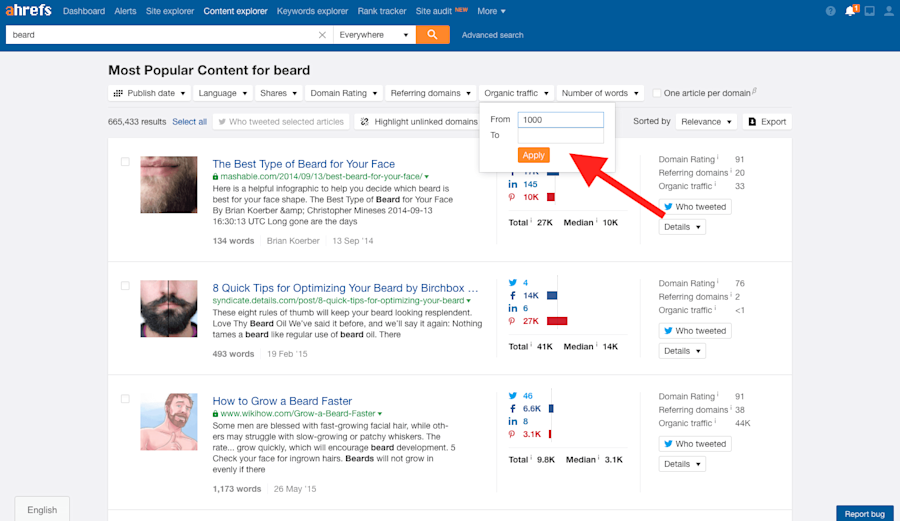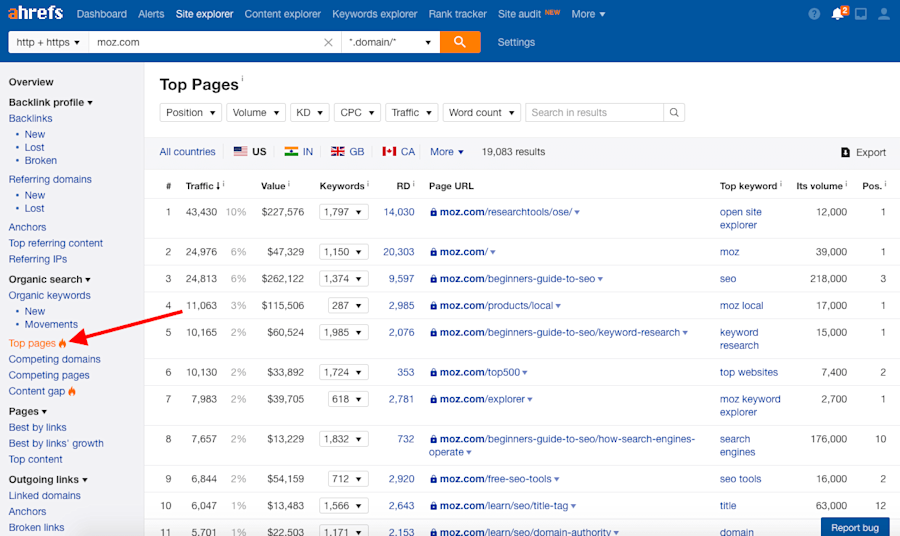The SEO industry is a competitive world. A quick Google search on the “best SEO tools” will bring you tons of blog articles listing hundreds of tools for every single aspect of SEO.

Similarly, thousands of SEO managers and digital marketers churn-and-burn through these tools every month, fully intent on finding the one tool that is the best bang for their buck.
In a field where almost everyone is savvy about the available marketing tactics, it is difficult to acquire customers, let alone retain them.
Yet, Ahrefs (which makes an SEO toolset to grow search traffic and research your niché) has done it.
Not only that, they have managed to grow their Annual Recurring RevenueARR several times in two years, despite being up against two larger competitors, Moz and SEMRush.
How did they do it?
What marketing strategies did they use?
I interviewed Tim Soulo, the Head of Marketing at Ahrefs, and he shared with me the exact marketing strategy he used to grow their ARR.

That story is below.
(Note: Driving new traffic to your website using content? Use our tool, Leadfeeder, to see which companies visiting, even if they never fill out a form. Try it free in minutes.)
A Trip Into Ahrefs Past
When Soulo first joined Ahrefs in 2015, Ahrefs’ marketing strategy was similar to any new, fledgling startup.
Imitation.
If their competitors had a blog, the Ahrefs team would set up a blog. If their competitors were publishing three-times-per week, they would publish three-times-per-week. If competitors were doing link roundups, they would do link roundups.
However, that wasn’t enough.
Even though Ahrefs had a pool of a few thousand users (because they were one of the few backlink analysis tools), Soulo knew they could do better.
Before that, there was something else he needed to do.
It was core to his beliefs.
“Marketing only works if the product is great.”
This meant he needed to fix the product.
For the entire first year at Ahrefs, Tim did not do a single activity that was traditionally classified as “marketing.” He did not personally produce any content, make any videos or run any ads.
Instead, while others continued “traditional” marketing like creating content — he went to work on the product and the user experience.
He envisioned the user journey and started improving it. It involved a lot of rewriting and redesigning. He redid the entire homepage.

He focused on cleaning up the product interface, brainstorming new features, creating hints within the product, making SEO reporting easier, and so on.
This gif nicely illustrates how much thought we put into the interface of each tool and feature that we release. Tha's how @Ahrefs Rank Tracker evolved :) pic.twitter.com/hIpGZGaq0n
And although these weren’t “marketing activities,” these iterations would eventually be the foundation of Ahrefs’ astonishing growth.
Why All Marketers Should Do Support
As part of the work to improve the product and its experience, Soulo also worked in support.
He answered customer queries via the Intercom support chat. He hopped onto Skype calls with customers to try to better understand how they used Ahrefs, and to learn what they can do to make the experience better.
It was through these customer calls, Soulo discovered what he describes as the “two driving forces of Ahrefs.”
“I noticed that a lot of people, when they sign up for Ahrefs, they sent me emails that said ‘I read your articles. I saw how you use Ahrefs for this, and this made me sign up.’”

It struck him.
It was so intuitive, so logical. And it had been blatantly obvious.
After all, it coincided with his own personal hypothesis for how people choose tools.
“My theory is that people don’t sign up for your tool and then learn how to use it. My theory is that people first learn how to use your tools, and they sign up because they know how to use your tool.”
From this, Soulo created the two driving forces of Ahrefs:
Force 1 - Explain to others why Ahrefs is better than the alternatives.
This was important because Ahrefs wasn’t the only SEO toolset in the market. In fact, there were existing, much bigger competitors. These were bigger brand names like Moz, SEMRush and Majestic.
Not only that, there were several smaller SEO tool sets competing for the same pool of users.
Thus, to compete effectively, Soulo had to ensure that Ahrefs’ marketing communicated every unique feature it had.
He wanted potential customers to know that these were features only available if they chose Ahrefs. He also wanted customers to be impressed by the number of features added to Ahrefs every month—features none of their competitors had.
Force 2 - Explain how to use Ahrefs.
The second driving force, was explaining to people how to use Ahrefs in the context of issues and challenges they had.
“In the first few years, Ahrefs was a pretty professional tool. If you know how to use it, you’d be able to navigate it. If you were kind of new-ish to SEO, you would log in and you wouldn’t find anything on how to use it.”
By educating readers on how to solve existing problems, using Ahrefs, customers and prospects learned to fix their issues and see how Ahrefs could be tremendously helpful in solving their problem.
This was in contrast with the strategy of many SaaS companies. Tons of SaaS companies were focused on creating top-of-the-funnel content—neglecting to mention how their tools played a part in solving the issues their content was covering.
This meant hundreds of thousands of visitors to their blogs, but hardly any conversions to signups.
This was where Ahrefs excelled.
These two driving forces eventually became the core of Soulo’s marketing strategy.
Simply put:
First, create content about topics that have search potential, so the company’s blog could get passive organic traffic to the site. Second, plug the Ahrefs toolset inside their content and demonstrate to visitors how to use Ahrefs better.
Here’s an example from one of their latest articles about Featured Snippets:

It has all come full circle.
By improving the product and coming up with more features, Tim created more opportunities to talk about Ahrefs features in the company’s content. As other companies have found using similar content strategies, by creating more content to show off the feature set, Tim also created more opportunities to improve the product through feedback.
It was a win-win-win for Tim, Ahrefs, and all of the company’s customers.
But now, the real question remains:
How can you apply Ahrefs’ growth strategy for yourself?
Here’s how you do it.
How To Apply Ahrefs’ Growth Strategy To Your Business
Step 1: Keyword Research
The first step to discovering topics with search potential is to do keyword research.
There are some incredible keyword research articles on the web, but here’s a quick rundown on how Soulo does his keyword research.
1. Keyword research tools
As the Head of Marketing of a SEO toolset, Soulo is lucky, in the sense, that he gets to use his own tool to do keyword research. Therefore, it is fairly obvious the first method he uses to do keyword research is his own Ahrefs Keyword Explorer.
First, enter a seed keyword (e.g. “SEO”) into Keyword Explorer:

Ahrefs will then generate a list of keyword ideas related to the seed keyword:

These are all potential content ideas you can write about.
If you do not have access to a keyword tool like Ahrefs, don’t worry. You can always look at using other (free) tools like:
To gather keyword volume for these tools, you can install the Keywords Everywhere extension (free).
2. Content tools
Another trick used by Soulo, is his own tool, Ahrefs Content Explorer. Ahrefs Content Explorer gathers and shows the web’s most popular content.

One particular trick Soulo uses is the “Content Explorer hack.”
First, enter a seed keyword into Content Explorer. In this case, I’m using the keyword “beards” as an example.

Content Explorer is now showing me all the most popular articles for the topic. Then, I’ll add a filter of organic traffic > 1,000.

Next, I’ll add a filter of referring domains = 0.

By adding these two filters, I’ve now uncovered all the articles related to “beards” which are garnering >1,000 organic traffic without any backlinks!

These means that any content you create about these topics will likely perform well in a search.
Of course, if you don’t have access to Content Explorer, you can always opt for the freemium alternative, Buzzsumo, to do a similar research.
3. Competitor Research
Another trick that Soulo uses, is looking out for what his competitors have already produced. It’s like a content audit — but for a competitor’s site. If these content pieces are performing well for his competitors, chances are it will perform well for Ahrefs.
To do this, enter a competitor domain into Ahrefs Site Explorer:

Hit the “Top Pages” tab. This will surface all your competitors’ pages sending the most organic traffic:

All you have to do is replicate the articles that are doing well for your competitors.
If you don’t have access to Ahrefs, you can also do this manually by heading over to your competitor’s blog. They (sometimes) feature their best performing articles:

Step 2: Create Your Content
Once you have a list of potential keywords you can target, it’s time to write your content.
With your keyword research complete, you aren’t going to create just any article.
You are going to write an article that follows two rules:
Your article should be unique, and it should match the search intent of the keyword.
Your article should be written in a way that soft-sells your product or educates the reader about your features.
Matching search intent is relatively easy. You can ask yourself a simple question: “What is someone looking for when typing this keyword?”
Of course, some keywords are obvious. Someone searching for “how to tie a tie” is looking for a tutorial on how to tie a tie. But some keywords—like marketing strategy—are vague.
To find out the exact search intent, enter your target keyword into Google and read the content appearing in the top 10 results. You should be able to spot some similarities amongst all the ranking content.
This similarity is the search intent.
Writing your article in a way that soft-sells your product or educates the reader about your features requires some copywriting prowess. Some topics lend themselves well to your product. For example, writing an article about competitive analysis gives Ahrefs plenty of opportunities to showcase its features.
Some other topics require more strategizing and planning. Here’s an example from Soulo:
“I had an example of a topic: how to submit your website to Google. This is a topic I discovered by browsing a magazine related to online business. I checked the topic in Ahrefs to see how much search traffic potential there was, and I saw that there was a pretty decent traffic potential.”

“Then I thought, ‘How do I plug Ahrefs into a topic of submitting your website to Google?’ And, actually, it’s pretty straightforward. Why do people want to submit their website to Google? Because they want to get found,” Soulo concluded.
“But, by submitting your website to Google, there is no guarantee that you will get found. Because you need backlinks. You need to understand the concept of keyword difficulty, how links help you rank, etc.”
“So, to write an article about this topic, you need to address the underlying issue. Tell people that, ‘You’ve submitted your website to Google, but don’t expect to rank.’ If you want to rank, you need to do this and that, and we have these tools to help you,” he says.

Step 3: Promote Your Content
The last step in Ahrefs’ growth strategy puts the word “marketing” in “content marketing.” It is not enough to create content; you have to promote it so that people know of it and can share, or link, to it.
However, content promotion is tough.
With so many pieces of content being produced a day, and so many marketing spammers around, content promotion is a game that gets more challenging every day.
One tactic you can follow is to find communities surrounding your niché, and promoting your articles inside.
After plenty of trial-and-error, these are the two promotion strategies Soulo uses:
1. Facebook Ads
By running Facebook ads, Soulo was able to drive a lot of new readers to Ahrefs’ blog for a very low cost-per-click.
One huge reason why Facebook Ads worked so well was because he already had the habit of investing in custom featured images for articles that were important to the Ahrefs’ blog. Here;s an example of a cool custom image for an article discussing keyword difficulty:

Another example from an article discussing link building:

These custom images are well-loved by Ahrefs customers:

And it plays a big part in their success with Facebook Ads. These images grab the attention of their potential readers, who then decide if they would like to read the articles.
2. In-app notifications
Soulo also realized that he could keep in touch with his customers by integrating a small notification icon within the Ahrefs tool itself.

This isn’t an aggressive push notification that everyone despises. Instead, it’s a soft call-to-action that highlights the new articles Ahrefs recently published.

These notifications get them a lot of traction because Ahrefs has a ton of users (ranging from free, trial and paid) that might be interested in what they’ve produced.
Takeaways
Will the Ahrefs strategy work for you?
It’s difficult to answer that question, but it has worked for Ahrefs:

At the end of the day, I feel the biggest takeaway of Ahrefs’ success is this quote from Soulo:
“I was at some conference, I don’t remember what it was, but there was a super awesome question that I had printed and stuck to my monitor.
‘How would next week’s customers learn about this week’s feature?’
Even if you release a feature and you send Intercom notifications or email, and we assume that all your existing customers have read them, you’re always getting new customers.
How do you let new customers know about these features when you released ten new features in the last few months?”
Now that you're here
Leadfeeder is a tool that shows you companies that visit your website. Leadfeeder generates new leads, offers insight on your customers and can help you increase your marketing ROI.
If you liked this blog post, you'll probably love Leadfeeder, too.
Sign up



